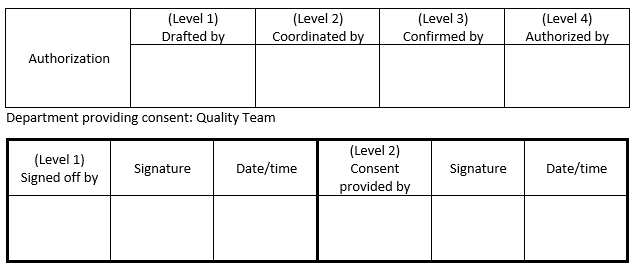Korean Legal Translation Accuracy Depends on a Clear Understanding of the Korean Company Decision-Making Process
The Korean company decision-making process is based on a strict hierarchical structure that is remarkably similar across the Korean business world. Therefore, it is critical to understand this protocol before translating Korean corporate documents. In this article, I explain about the authorization grid commonly used in Korean companies. I also present translations that inexperienced translators produce in Korean legal translation work and suggest improvements.
- Target audiences: Translators seeking to improve their Korean legal translation work; business people doing business with Korean companies who need to understand how their Korean counterparts reach decisions; attorneys and lawyers engaged in litigation and other legal matters involving Korean companies who need to understand translations of Korean documents
Keywords: korean company decision-making, korean legal translation, korean company hierarchy, korean company
Why Is It Important to Understand Decision-Making in Korean Companies?
I frequently translate Korean corporate documents for the discovery phase of international litigation involving Korean companies. These projects involve translating internal Korean emails and reports of one party to the lawsuit that the other party’s legal counsel needs to understand in order to prosecute their case. Sometimes a case rests on who knew what and when, and who gave authorization to do what and when. Therefore, accurate translation of the reporting and decision-making protocol in these documents is critical. A Korean translator who does not adequately understand how the authorization process works within Korean companies and doesn’t take a best-practice approach to translating the relevant content can inadvertently leave out or distort important meanings.
Examples of the Korean Company Decision-Making Grid
Decision-making grids (or tables) in the internal documents of Korean companies come in various shapes and sizes. However, most are similar to the two examples below. The words across the top describe steps in the process, and the empty spaces are filled in by the individuals executing each step. Authorization steps move up the hierarchy from left to right in the table.
Example 1: A Generic Korean Company Authorization Grid
Many internal documents of Korean companies include authorization grids similar to the following.

A translation might read as follows.

The empty boxes usually contain at least the signatures of people involved in authorizing the document or actions described in the document. Sometimes, these boxes also include printed names, job positions and/or times and dates. In addition, if users only follow some of the authorization steps, the boxes for the steps not included remain blank. The column with the left-most empty box (under “Drafted by”) is the lowest level of authorization. In this case, it merely indicates who put the document together. The second (“Coordinated by”) would likely be a direct supervisor involved in the drafting. The next column (“Confirmed by”) would be a third-level authorization, with the highest-ranking person in the process signing the far-right cell (“Authorized by”).
Example 2: A Two-Level Korean Company Decision-Making Scenario
While the basic process and grid layout are somewhat standardized across departments and companies, the terminology and organizational levels in the authorization protocol vary. Here’s another example:

In this case there are two levels in the authorization process. The left three columns cover the first-level authorization and the second three columns fall under a second level. Based on having translated “결재” above as “Authorized by”, we might expect the following translation.

However, this would be misleading in a Korean legal translation. At the first-level in the authorization process, the word “authorization” is not really suitable. This is more of a “sign off” or “check off” step before passing the document up for what we would generally think of in English as “authorization”. Therefore, a preferred translation in this example would be as follows:

The word “결재” is a difficult word to translate in Korean legal translation work. This is because the best English term varies by context. This term also possessed a generic meaning that overlaps with the meanings of other words. As indicated above, while the overall authorization (결재) process can be referred to as “authorization” or “authorization protocol”, a word that doesn’t indicate actual authority is more suitable when the word 결재 is used at the lowest level. In addition, combining the word in other ways might further change the English translation. A good translation for 전자결재 is “electronic signature”, not “electronic authorization”. And in a process where 승인여부(“whether approved”) is followed by 결재 (as in “yes, it was approved”), translating 결재 as “approved” would maintain the flow in English. Thus, the translator cannot just map the Korean term one-for-one with an English term and use that translation rigidly.
Improving the Korean Legal Translations in the Examples Above
Problem
Sometimes a translator working on Korean legal translation needs to go beyond a literal translation by providing another level of meaning that gives readers an accurate understanding of the process. Notice how the sequences of Korean terms used in the two examples of Korean company decision-making above don’t match. (Example 1: 기안 > 조정 > 확일 > 결재; Example 2: 결재 > 합의). This is because there is no standardized system for this (unlike the standard hierarchy of job titles, which does remain remarkably consistent across Korean companies). Thus, other terms pop up in the decision-making system too, including 재가, 승인 and 통보, and suitable translations for these could be “sanction”, “approval” and “notified to”, respectively. “Notified to” clearly has the meaning that the information was merely provided but approval not given. However, the difference between “Consent provided by”, “Approved by”, “Authorized by” or “Sanctioned by” are not as apparent. Further, since the Korean terms (합의, 승인, 결재, 재가, respectively) each mean basically the same thing too, any translation of these terms from Korean to English must be arbitrary at best.
Solution
The Korean legal translator must recognize that each Korean term takes on a unique meaning based on context. In other words, each Korean company chooses what term to use for each level of approval. Thus, translating a Korean term without indicating its level cannot convey all of the meaning necessary for an outsider to understand the process. Here are expanded translations of the above tables. These explicitly state the level in order to fully communicate the meaning.

On a larger Korean legal translation project, the translator is likely to have enough context to fully understand the situation. In this case, translations like “working-level authorization”, “manager-level authorization” or “executive-level authorization” could help the reader (i.e. the client) understand the authorization levels. Naturally, even though the specific English words used to translate each term may be arbitrary, it is very important to be consistent. Thus if 재가 means “sanction” in one place, it can’t mean something else elsewhere in the same context.
Other Considerations When Translating Texts Related to Korean Company Decision-Making
Phrasing
I have seen translations where the Korean legal translator wrote “Drafter” instead of “Drafted by” or “Consenter” instead of “Consent provided by”. There are two reasons I now follow the latter approach and not the former. The first is that the expression sounds stilted without using the preposition “by” and a specific reference to the actor. For example, this approach results in the following: “drafter”, “coordinator”, “confirmer”, “authorizer”, “signer”, “consenter”, “approver”, “sanctioner”, “notifyee”. Secondly, the former approach does not allow the translator to differentiate when the Korean source refers to the actor elsewhere (e.g., 기안자, 조정자, 확인자, 결재자, 합의자, 승인자).
Other Terms
- 전결
The dictionary invariably provides “arbitrary decision” as the translation for this term. Not only does this expression sound awkward, it also doesn’t communicate the real meaning effectively. This is because “arbitrary decision” carries a negative connotation in English. Readers might mistake it for a “random decision” or something else done for no good reason. Therefore, a better translation needs to explain the full meaning of the word in the context of Korean company decision-making. In fact, 전결 refers to the authority delegated under the company’s hierarchy to a person in their official position to make certain decisions.
Though a little long, either “decision made under official authority” or “decision made under delegated authority” would be better. The version with “delegated” catches the root meaning of the Korean word more literally. However, in my mind, it seems to imply that someone is making a decision on behalf of someone else (who might not just be at work that day or something), rather than a decision that is rightfully theirs to make in their position within the organizational structure of the company. I prefer “decision made under official authority” or “make a decision under official authority”. Likewise, 전결권 means “official decision-making authority” and 전결권자 translates to “person with official decision-making authority”.
- 대결 – Though often too long to meet space constraints, I prefer “decision made on behalf of someone else”.
- 직권 – “official decision”
- 직권면직 – This refers to taking away someone’s job authority. A usable translation in a Korean legal translation might be “revocation of authority”.
Conclusion
Decision-makers in Korean companies nearly always make their decisions along a strict organizational lines. When translating the related terms, a translator must do more than just translate using dictionary definitions. This is because the cultural context that informs the decision-making process is a critical factor in understanding the circumstances, and dictionary definitions are often misleading and stilted. The best Korean translators on Korean legal translation projects embed as much insight as possible into the translations they produce of Korean corporate documents.
Why Is It Important to Understand Decision-Making in Korean Companies?
I frequently translate Korean corporate documents for the discovery phase of international litigation involving Korean companies. These projects involve translating internal Korean emails and reports of one party to the lawsuit that the other party’s legal counsel needs to understand in order to prosecute their case. Sometimes a case rests on who knew what and when, and who gave authorization to do what and when. Therefore, accurate translation of the reporting and decision-making protocol in these documents is critical. A Korean translator who does not adequately understand how the authorization process works within Korean companies and doesn’t take a best-practice approach to translating the relevant content can inadvertently leave out or distort important meanings.
Examples of the Korean Company Decision-Making Grid
Decision-making grids (or tables) in the internal documents of Korean companies come in various shapes and sizes. However, most are similar to the two examples below. The words across the top describe steps in the process, and the empty spaces are filled in by the individuals executing each step. Authorization steps move up the hierarchy from left to right in the table.
Example 1: A Generic Korean Company Authorization Grid
Many internal documents of Korean companies include authorization grids similar to the following.

A translation might read as follows.

The empty boxes usually contain at least the signatures of people involved in authorizing the document or actions described in the document. Sometimes, these boxes also include printed names, job positions and/or times and dates. In addition, if users only follow some of the authorization steps, the boxes for the steps not included remain blank. The column with the left-most empty box (under “Drafted by”) is the lowest level of authorization. In this case, it merely indicates who put the document together. The second (“Coordinated by”) would likely be a direct supervisor involved in the drafting. The next column (“Confirmed by”) would be a third-level authorization, with the highest-ranking person in the process signing the far-right cell (“Authorized by”).
Example 2: A Two-Level Korean Company Decision-Making Scenario
While the basic process and grid layout are somewhat standardized across departments and companies, the terminology and organizational levels in the authorization protocol vary. Here’s another example:

In this case there are two levels in the authorization process. The left three columns cover the first-level authorization and the second three columns fall under a second level. Based on having translated “결재” above as “Authorized by”, we might expect the following translation.

However, this would be misleading in a Korean legal translation. At the first-level in the authorization process, the word “authorization” is not really suitable. This is more of a “sign off” or “check off” step before passing the document up for what we would generally think of in English as “authorization”. Therefore, a preferred translation in this example would be as follows:

The word “결재” is a difficult word to translate in Korean legal translation work. This is because the best English term varies by context. This term also possessed a generic meaning that overlaps with the meanings of other words. As indicated above, while the overall authorization (결재) process can be referred to as “authorization” or “authorization protocol”, a word that doesn’t indicate actual authority is more suitable when the word 결재 is used at the lowest level. In addition, combining the word in other ways might further change the English translation. A good translation for 전자결재 is “electronic signature”, not “electronic authorization”. And in a process where 승인여부(“whether approved”) is followed by 결재 (as in “yes, it was approved”), translating 결재 as “approved” would maintain the flow in English. Thus, the translator cannot just map the Korean term one-for-one with an English term and use that translation rigidly.
Improving the Korean Legal Translations in the Examples Above
Problem
Sometimes a translator working on Korean legal translation needs to go beyond a literal translation by providing another level of meaning that gives readers an accurate understanding of the process. Notice how the sequences of Korean terms used in the two examples of Korean company decision-making above don’t match. (Example 1: 기안 > 조정 > 확일 > 결재; Example 2: 결재 > 합의). This is because there is no standardized system for this (unlike the standard hierarchy of job titles, which does remain remarkably consistent across Korean companies). Thus, other terms pop up in the decision-making system too, including 재가, 승인 and 통보, and suitable translations for these could be “sanction”, “approval” and “notified to”, respectively. “Notified to” clearly has the meaning that the information was merely provided but approval not given. However, the difference between “Consent provided by”, “Approved by”, “Authorized by” or “Sanctioned by” are not as apparent. Further, since the Korean terms (합의, 승인, 결재, 재가, respectively) each mean basically the same thing too, any translation of these terms from Korean to English must be arbitrary at best.
Solution
The Korean legal translator must recognize that each Korean term takes on a unique meaning based on context. In other words, each Korean company chooses what term to use for each level of approval. Thus, translating a Korean term without indicating its level cannot convey all of the meaning necessary for an outsider to understand the process. Here are expanded translations of the above tables. These explicitly state the level in order to fully communicate the meaning.

On a larger Korean legal translation project, the translator is likely to have enough context to fully understand the situation. In this case, translations like “working-level authorization”, “manager-level authorization” or “executive-level authorization” could help the reader (i.e. the client) understand the authorization levels. Naturally, even though the specific English words used to translate each term may be arbitrary, it is very important to be consistent. Thus if 재가 means “sanction” in one place, it can’t mean something else elsewhere in the same context.
Other Considerations When Translating Texts Related to Korean Company Decision-Making
Phrasing
I have seen translations where the Korean legal translator wrote “Drafter” instead of “Drafted by” or “Consenter” instead of “Consent provided by”. There are two reasons I now follow the latter approach and not the former. The first is that the expression sounds stilted without using the preposition “by” and a specific reference to the actor. For example, this approach results in the following: “drafter”, “coordinator”, “confirmer”, “authorizer”, “signer”, “consenter”, “approver”, “sanctioner”, “notifyee”. Secondly, the former approach does not allow the translator to differentiate when the Korean source refers to the actor elsewhere (e.g., 기안자, 조정자, 확인자, 결재자, 합의자, 승인자).
Other Terms
- 전결
The dictionary invariably provides “arbitrary decision” as the translation for this term. Not only does this expression sound awkward, it also doesn’t communicate the real meaning effectively. This is because “arbitrary decision” carries a negative connotation in English. Readers might mistake it for a “random decision” or something else done for no good reason. Therefore, a better translation needs to explain the full meaning of the word in the context of Korean company decision-making. In fact, 전결 refers to the authority delegated under the company’s hierarchy to a person in their official position to make certain decisions.
Though a little long, either “decision made under official authority” or “decision made under delegated authority” would be better. The version with “delegated” catches the root meaning of the Korean word more literally. However, in my mind, it seems to imply that someone is making a decision on behalf of someone else (who might not just be at work that day or something), rather than a decision that is rightfully theirs to make in their position within the organizational structure of the company. I prefer “decision made under official authority” or “make a decision under official authority”. Likewise, 전결권 means “official decision-making authority” and 전결권자 translates to “person with official decision-making authority”.
- 대결 – Though often too long to meet space constraints, I prefer “decision made on behalf of someone else”.
- 직권 – “official decision”
- 직권면직 – This refers to taking away someone’s job authority. A usable translation in a Korean legal translation might be “revocation of authority”.
Conclusion
Decision-makers in Korean companies nearly always make their decisions along a strict organizational lines. When translating the related terms, a translator must do more than just translate using dictionary definitions. This is because the cultural context that informs the decision-making process is a critical factor in understanding the circumstances, and dictionary definitions are often misleading and stilted. The best Korean translators on Korean legal translation projects embed as much insight as possible into the translations they produce of Korean corporate documents.



